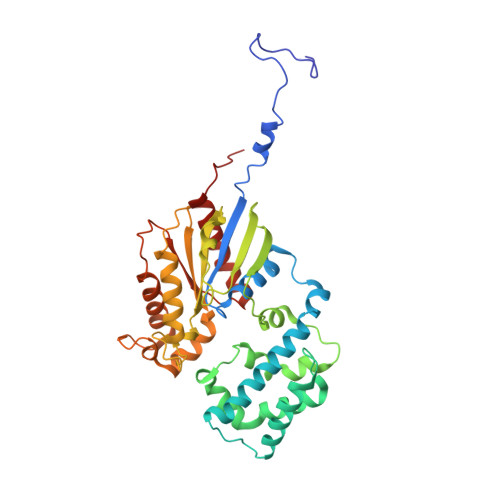A constitutively active G-alpha subunit provide insights into the mechanism of G protein activation
Singh, G., Ramachandran, S., Cerione, R.A.(2012) Biochemistry 51: 3232-3240
- PubMed: 22448927
- DOI: https://doi.org/10.1021/bi3001984
- Primary Citation of Related Structures:
3V00 - PubMed Abstract:
The activation of Gα subunits of heterotrimeric G proteins by G protein-coupled receptors (GPCRs) is a critical event underlying a variety of biological responses. Understanding how G proteins are activated will require structural and biochemical analyses of GPCRs complexed to their G protein partners, together with structure-function studies of Gα mutants that shed light on the different steps in the activation pathway. Previously, we reported that the substitution of a glycine for a proline at position 56 within the linker region connecting the helical and GTP-binding domains of a Gα chimera, designated αT*, yields a more readily exchangeable state for guanine nucleotides. Here we show that GDP-GTP exchange on αT*(G56P), in the presence of the light-activated GPCR, rhodopsin (R*), is less sensitive to the β1γ1 subunit complex than to wild-type αT*. We determined the X-ray crystal structure for the αT*(G56P) mutant and found that the G56P substitution leads to concerted changes that are transmitted to the conformationally sensitive switch regions, the α4-β6 loop, and the β6 strand. The α4-β6 loop has been proposed to be a GPCR contact site that signals to the TCAT motif and weakens the binding of the guanine ring of GDP, whereas the switch regions are the contact sites for the β1γ1 complex. Collectively, these biochemical and structural data lead us to suggest that αT*(G56P) may be adopting a conformation that is normally induced within Gα subunits by the combined actions of a GPCR and a Gβγ subunit complex during the G protein activation event.
- Department of Molecular Medicine and Department of Chemistry and Chemical Biology, Cornell University, Ithaca, New York 14853, United States.
Organizational Affiliation:

















